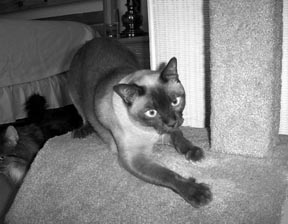Does your furniture have little shreds of fabric hanging from the corners? Does your relatively new area rug look more than a little disheveled? Do your cupboards suffer from telltale claw marks? If so, you need to understand that your cat isnt out to destroy your property – she is merely satisfying her natural urges in the best way she knows how.

288
Cats scratch objects to remove the sheaths of their nails and to mark their territories. And the stretching or climbing involved in the process is a way to exercise and flex their muscles. Its important to recognize that scratching is normal behavior, says Ilona Rodan, DVM, of the Cat Care Clinic in Madison, WI.
The gradual destruction of your belongings may make you want to tear your hair out, but providing your cat with appropriate and desirable scratching areas is a less stressful approach for both of you. Its always easiest to prevent the problem rather than try to fix it, says Dr. Rodan. You accomplish this by training the cat to use proper materials from the start.
First, you need to isolate the type of surface your cat enjoys most. If you find bits of your wall-to-wall pulled from the nap, your cat enjoys scratching carpet. If shes attracted to your dining table legs, she may prefer wood. Other cats may enjoy exercising their options with sisal or cardboard. Different cats have different preferences, says Dr. Rodan.
Dont expect your cat to automatically appreciate (and use) the first scratching post you provide for her, either. You may need to provide a few different surfaces before finding the best one to guide your cats behavior.
The Importance of Mixed Media
To redirect your cats natural scratching behavior, provide her with a scratching post. The best scratching post for your cat combines different scratching media and has multi-levels on which your cat can claw, climb, and exercise. An ideal scratching post is made of a variety of materials, says Dr. Rodan.
Getting your cat to use the post may be as simple as placing it in the location she prefers, such as in front of the sofa corners or next to the dining table. Cats like to stretch and scratch after a good sleep, says Dr. Rodan. Therefore, putting the post near where your cat enjoys napping may be the best location.
Type of Scratching Tells You Something
Does the height or position of the post matter? If your cat has started working on your sofa, she may prefer to stretch vertically. Some cats like vertical surfaces and some prefer horizontal ones, says Dr. Rodan. The Alpine Scratcher from Cosmic Pet Products (see sidebar) is a corrugated cardboard mat that fits into a slanted frame, which fits the natural contour of a stretching cat. Its less costly than other materials, says Dr. Rodan, and your cat can use it as a ramp if getting to a favorite sleeping spot is difficult.
You can make the post interesting by providing a tall one with spaces your cat can curl up in, or to jump from one to the other. Tall posts also increase the use of vertical space in your home. Cats like to be on high perches to oversee whats going on, says Dr. Rodan.
Encourage your cat to use her post by sprinkling some catnip on it, and when you see your cat using it, praise her and offer her treats. Reward your cat for using the post and the correct scratching surfaces, says Dr. Rodan.
Foiling Your Feline
If Fluffy has already targeted your home furnishings, its important to dissuade her from going back to them. There are many humane ways to keep her from scratching your belongings. Covering the arms of sofas or chairs with aluminum foil or plastic such as Sofa Savers (see sidebar) will keep her from clawing them. An alternative is to cut and attach a plastic rug runner knobby side up to the corners of upholstered furniture. Wrapping table legs in bubble wrap until your cat is accustomed to using her scratching post will protect the table and discourage her continued attraction to it.
Wipe clawed surfaces with an odor neutralizer to remove your cats scent before applying a protective covering. Double-sided sticky tape may leave a residue on your furniture, so opt for a product like Sticky Paws (see sidebar) to keep your cat from scratching undesirable locations, including digging in plants. Sticky Paws dont feel bad to the cat, and theyre in place all the time whether the pet caregiver is home or not, says Dr. Rodan.
Avoid Physical Punishment and Scare Tactics
Physical punishment or squirt bottles usually wont help because your cat will learn to scratch your furniture when youre not home or not looking. Booby traps such as stacks of soda cans just traumatize your cat, and may traumatize you in the process.
If you are planning to replace your furniture, opt for items that cats find unappealing, such as velour, faux fur or velvet. Wood-framed furniture is another option. Avoid heavy woven fabrics because they tend to draw cats like a magnet.
Keeping your cats claws clipped will help keep her from trimming her nails in your couch. Ask your veterinarian to show you how to trim your cats nails, and teach your cat to have her nails clipped when you first adopt her. Associate the process with tasty treats and praise, says Dr. Rodan.



